Finally we have successfully rebalanced the hooves and achieved an accurate M/L balance, only to discover to our dismay a few weeks later that same M/L imbalance again. What went wrong with our last trim, we might ask ourselves? Really nothing probably went wrong, a great job could have been done, it is just that the Law Of Least Resistance took over again.
No horse has perfect conformation. At least, I have not encountered one. So when evaluating hoof growth and hoof balance, it is important to look at the horses conformation first, because that conformation is the decisive factor which part of a hoof grows more or less. A hoof grows more where it experiences less pressure or loading. A narrow based horse, as an example, where the lower legs and hooves end up inside a plum line drawn from the shoulder, will exert more pressure on the lateral sides of both hooves while standing. Let’s look at the photo below.
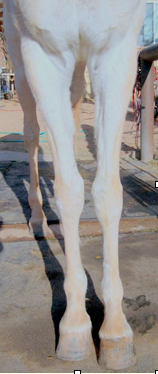
This horse is extremely narrow based, the medial side will grow much more, because most pressure is exerted on the lateral sides of both hooves. The opposite would be true for a wide stance horse.
Let’s look at another one.
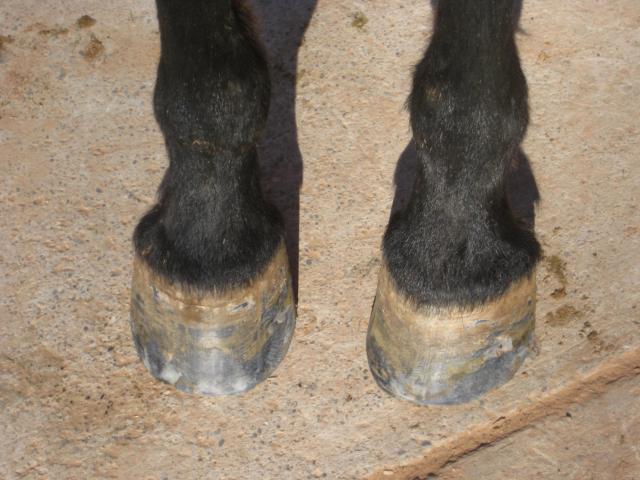
This horse is narrow based and on top of it, pigeon toed. The lateral hoof walls will experience even more pressure compared to the medial hoof walls, allowing them to grow much easier and much more. Within a trimming cycle, the inside of both hooves will have grown a lot more, because the loading is less there. At every trim, we have to take therefore more hoof wall off the medial side. And this will never change. Failing to do so, can cause quarter cracks and severe lameness. Within a six-week trimming cycle, the medial heel bulbs and coronet bands could also experience an upward displacement. To correct coronet bands that are vertically displaced or ‘shoved up’, to use a jargon frequently used, we can float the affected heel. What does that mean? It means shortening the heel length to the same level medially and laterally and allowing that ‘shoved up’ part of the hoof to settle down and relax. In essence, we are shortening the heels more on the displaced side when looking at the plane of the sole
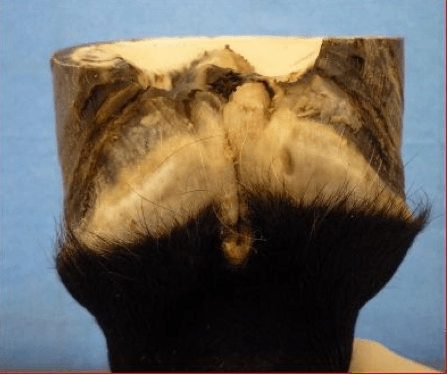
Looking straight at the heels of this hoof and the heel bulbs, we notice the vertical displacement on the left side. When shortening the left heel so both heel lengths (measured from the heel to the coronet band at the bulb) are the same, we allowing the distressed side to relax and settle down.
Here the same photo with arrows indicating how to measure the length of the heel. Both green arrows measure the length, (not height) of the heels, the red shows how much more that heel was shortened to achieve the same heel length laterally and medially.
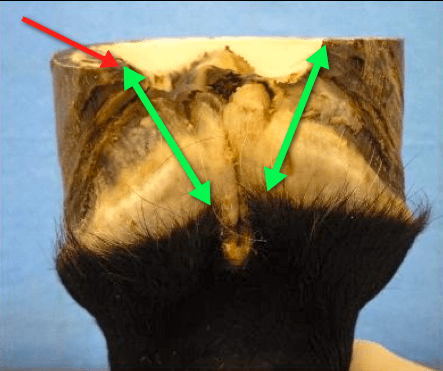
If we would have trimmed both heel to a level plane, you can see how much longer the left heel would be compared to the right one.
Initially the shortened hoof side will be hanging in the air, so to speak, but within a relative short period of time it will settle down to have ground contact again.
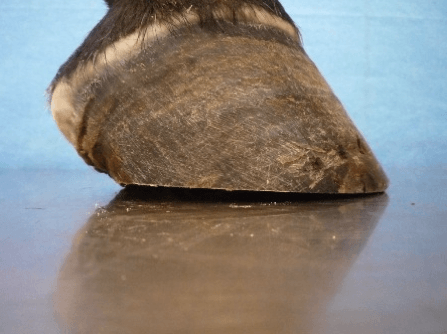
How long will it take? That depends on the moisture content of the hoof, the time frame of how long the vertical displacement has been allowed to go unchecked and the hardness of the ground. Under favorable conditions, the hoof can settle down within half an hour. If the hoof capsule has been distorted for a longer period of time, the hoof itself is dry and hard, the ground is soft, it may take days for the hoof to regain its balanced shape.
So, can you apply hoof protection? Absolutely. You can use any kind of Easyboots during your work out and ride. Just apply them for the ride and take them off afterwards. When gluing on Easyboot Glue-Ons or EasyShoes, however, make sure you firmly press the shoes or Glue-On boots onto the hoof as it is trimmed. Do not fill the part of the recessed hoof wall with glue, otherwise the hoof capsule cannot relax and regain its balance. Basically you would substitute and rebuild the trimmed side with glue and your trimming and floating will get negated. So either wait till the hoof capsule has relaxed completely or apply even pressure onto both sides of the hoof wall before setting the hoof down.
Next month we will look closer at trimming the heels to the appropriate length, which parameters we can use to do that and I will share with you the names of the two hoof care professionals who have been advocating the equal heel length theory in seminars in several countries of the world and may come to the USA this fall, so stay tuned.
From the desk of the Bootmeister.
Christoph Schork, www.globalendurance.com




